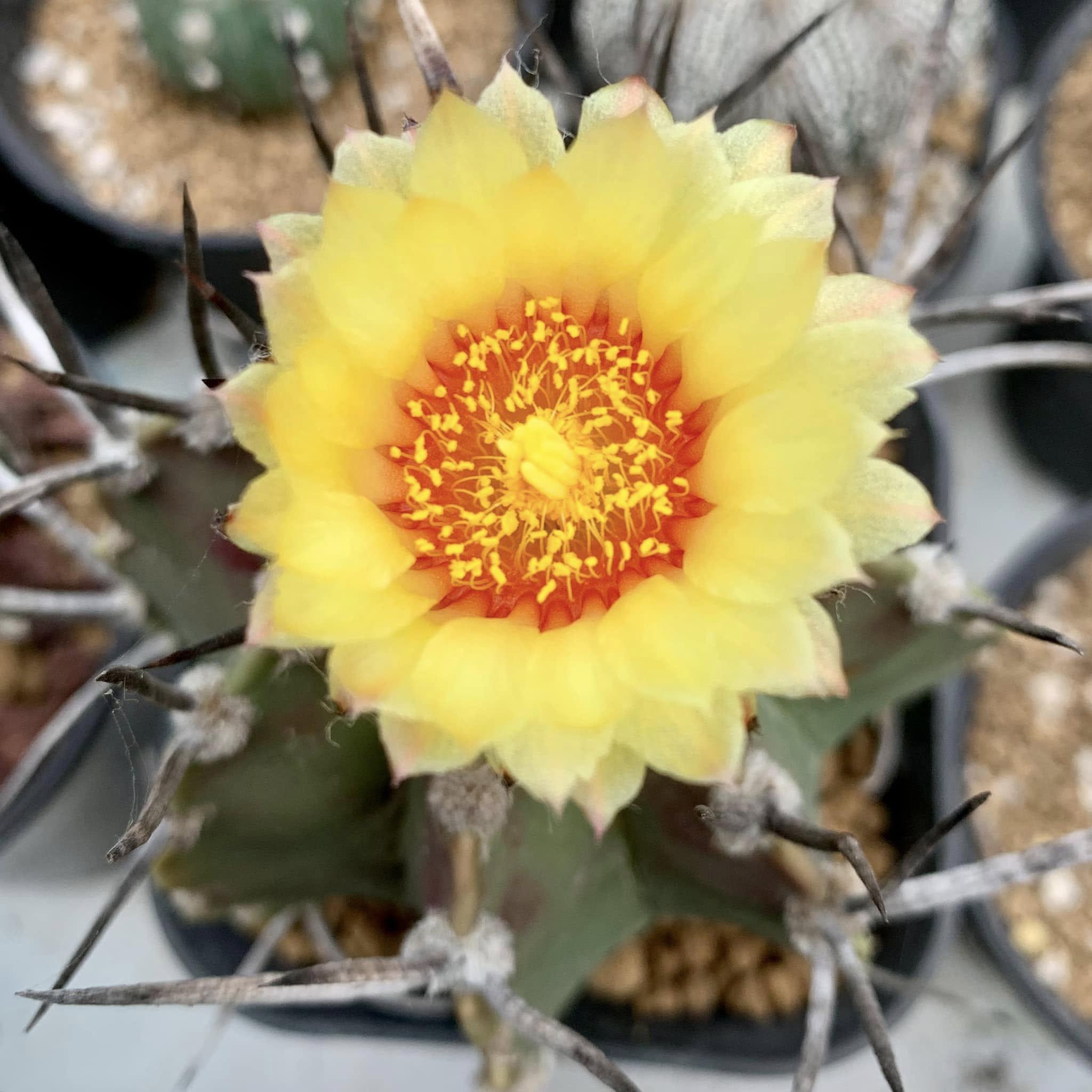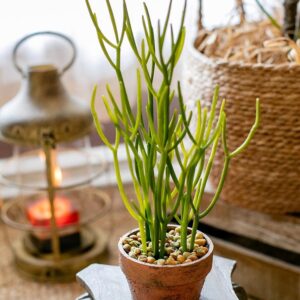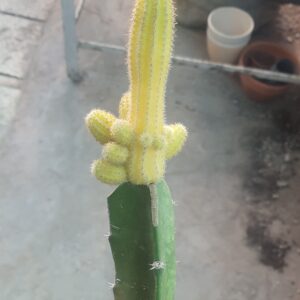Astrophytum capricorne“🌵 The Goat’s Horn Cactus
The Astrophytum capricorne is a slow-growing, globular to columnar cactus native to the Chihuahua desert of Northern Mexico. Its most striking feature is its long, curved spines, resembling a goat’s horn, which give the plant its name. Combined with the cactus’ speckled surface (white dots) and showy yellow blooms, this species is highly sought after by collectors and succulent enthusiasts.
🌿 Botanical Overview
Scientific Name: Astrophytum capricorne
Common Names: Goat’s Horn Cactus, Star Cactus
Family: Cactaceae
Origin: Northern Mexico (Coahuila and surrounding regions)
Type: Perennial, globular to cylindrical cactus
Size:
Height: 6–12 inches (15–30 cm)
Diameter: 3–5 inches (7.5–12.5 cm)
Ribs: 8–10 distinct ribs
Spines: Long, twisted, brown to black, sometimes interlacing
Surface: Green with white flecks (trichomes) that protect from sun
Flowers: Large, yellow with a red throat, 2–3 inches wide
Blooming Time: Summer, often after reaching maturity (3–5 years)
☀️ Sunlight and Temperature Needs
Sunlight:
Needs full sun to partial shade
At least 5–6 hours of bright, direct sunlight daily for healthy growth
Too much intense sun can scorch the plant; filtered light is ideal in very hot climates
Temperature:
Thrives between 20°C and 35°C
Tolerates brief drops to –5°C (23°F) if kept dry, but ideally protected from frost
Suitable for USDA Hardiness Zones 9b–11
🌤️ In areas with intense summer heat, provide afternoon shade to prevent sunburn.
💧 Watering Routine
Growing Season (Spring to Early Fall):
Water thoroughly when the soil is completely dry
Typically every 2–3 weeks, depending on temperature and humidity
Ensure water drains fully—avoid stagnant moisture
Dormant Period (Late Fall to Winter):
Water sparingly or not at all
Keep dry during cold months to prevent rot
💧 Tip: Use the “soak and dry” method — water deeply, then wait until soil dries out completely.
🌱 Soil Requirements
Type:
Requires well-draining cactus or succulent soil
Ideal mix: 50% commercial cactus mix + 50% pumice, perlite, or coarse sand
pH: Slightly acidic to neutral (6.0–7.0)
🌿 Poor drainage is the most common cause of root rot — prioritize aerated, gritty soil.
🌾 Fertilizing Schedule
Active Growth (Spring to Summer):
Feed with a low-nitrogen cactus fertilizer (e.g., 5-10-10) every 4–6 weeks
Optional: Diluted liquid fertilizer at half strength
Fall to Winter:
Stop fertilizing during dormancy
✂️ Pruning and Maintenance
Pruning:
Not required except to remove dead or damaged flowers
Avoid removing spines, as they protect from sun and pests
Maintenance Tips:
Rotate potted plants occasionally to ensure even sun exposure
Check for pests and remove debris from the cactus body
🌿 Propagation Methods
By Seed:
Primary method of propagation
Germinate seeds in a warm (20–25°C), moist, and well-drained soil
Use a cactus propagation mix in shallow trays
Seeds typically germinate in 2–6 weeks
Offsets:
Rare for Astrophytum capricorne—usually propagated from seed
🌱 Seed-grown plants may take 3–5 years to flower, but reward patience with stunning blooms.
🐛 Pests and Common Problems
Pests:
Mealybugs (especially at roots)
Spider mites
Scale insects
Diseases:
Root rot from overwatering
Fungal infections in poor ventilation
🛡️ Apply neem oil or insecticidal soap for pest control, and ensure good airflow around the plant.
🌸 Flowering and Aesthetic Appeal
Blooms:
Produces bright yellow flowers with a red center, up to 3 inches wide
Flowers typically appear in summer, multiple times in a season if well cared for
Decorative Use:
Ideal for cactus displays, rock gardens, and container gardens
Perfect for indoor sunlit spaces, patios, and greenhouses
📸 The spiraling, horn-like spines make it a visual standout in any cactus collection.
✅ Conclusion
The Astrophytum capricorne is a captivating, low-maintenance cactus that combines architectural beauty, unique spines, and showy flowers. Its resilience and drought tolerance make it perfect for desert-themed gardens or indoor collections for those with sunny spots.
With correct care — especially proper watering and bright light — this cactus can live for decades, rewarding you with rare and spectacular blooms.”





Reviews
There are no reviews yet.